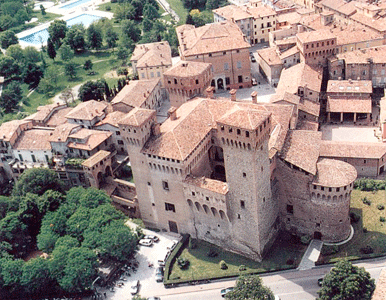Vignola, the city of cherries
Vignola, whose name derives from the Latin vineola, small vine, was firstly mentioned in 826 as a road junction and strategic centre revolving around its Fortress, one of the most impressive defensive bulwarks in the region.
Firstly mentioned in the 9th century, it was probably founded by St. Anselmo, the abbot of Nonantola, to suit defensive purposes. Acquired by the Bishop of Modena in the 10th century, the Fortress was subsequently controlled by the Municipality of Modena up to 1227, owned by the Grassoni family until the moment the Estensi family extended their dominion here under the supervision of Uguccione of the Contrari Family from Ferrara (1401) and finally bought by the Boncompagni family, which retained it for more than two centuries, from 1577 to 1796.
In the nineteenth century the Fortress was the seat of several municipal offices, the library and the new Cassa di Risparmio di Vignola. The latter bought it in 1965, but sold it again to the Fondazione Cassa di Risparmio di Vignola in 1998. 
The Fortress boasts an impressive quadrangular structure whose towers gaze across the countryside from on high: the oldest Torre Nonantola, Torre delle Donne, Torre del Pennello and the Clock Tower.
A drawbridge connects the entrance with the courtyard, whose portal leads to the three halls of the ground floor, embellished by coats of arms and 15th-century heraldic devices. The names of the Halls of the Fortress derive from the recurrent patterns which embellish the frescos dating back to the first half of the 15th century, the age during which the Contrari Family yielded its power in the surrounding area.
In front of the Fortress is Palazzo Boncompagni by architect Jacopo Barozzi, which is characterized by an outstanding rusticated portal and a staircase provided with oval plan and hanging steps by Bartolomeo Tristano.
Via Garibaldi leads to the Clock Tower and the Parish Church of SS. Nazario and Celso, which was firstly mentioned in 1299 but was then rebuilt in 1680 and completed in the 19th century; outside is a beautiful facade surmounted by a decorated pediment; inside are a nave and two aisles cherishing paintings by Elisabetta Sirani, Adeodato Malatesta and Francesco Stringa, as well as a bronze Pietà by local sculptor Ivo Soli.
A short distance from the city centre is the ancient Sanctuary of Madonna della Pieve, which was commissioned by Liutprando, the King of the Lombards, in 1174. The ancient building was situated a short distance from Campiglio, at the foot of the hills bordering via Claudia. In 1665, an oratory was built exploiting the apses of the former church, which collapsed in 1400. The Sanctuary named after Madonna della Pieve hosts a 13th-century statue portraying the Madonna and Child. The building still retains a seventeenth-century style and is provided with a lovely arcade and a small bell tower.
Villa Tosi-Bellucci, which has hosted the Town Hall since 1916, boasts a Neoclassical square central body. Only one tower out of four remains, the so-called Galvani Tower, which is part of the targeted itineraries which extend across the so-called "Tower Houses". Its outstanding terraced garden, realized in the 15th century, can be seen from the road. Not to be missed is the Neoclassical Villa of the Galvani family.
In the lovely old town of Vignola, in via Selmi 2, is the Native House of Ludovico Antonio Muratori, the first historiographer in Italy. From September to June, it hosts exhibitions and displays by artists from all over Italy. Apart from its historic - artistic heritage of great value, Vignola is also renowned all over Europe for its cherries and plums.
The cherry production starts in the second half of May, when the
so-called “Durone Bigarreau” cherries ripen followed by the famous “Mora di
Vignola” ones. In June the dark-coloured cherries named "Nero I" and "Anella"
ripen, followed by the late “Nero II” and “Ciliegione” (mid June).
Other appreciated staples are apricots, apples and wine produce. Vignola also boasts an outstanding confectionery tradition which is best represented by Torta Barozzi (Barozzi Cake), which is named after the illustrious architect from Vignola Jacopo Barozzi.
- Native house of Giuseppe Verdi
- Holidays Porretta Terme
- Room of the tricolour, Museum of the Tricolour
- Fortress of Castell'Arquato
- Park of the Po Delta and Marshes of Comacchio
- Modena's Duomo
- Castle of Torrechiara
- Marzabotto and Montesole Historical Park
- Modena's Ghirlandina
- Ferrara's old town
- Sarsina, Sanctuary of St. Vicinio
- Archaeological site Velleia Romana
- Castles of Reggio Emilia
- Visiting Sasso Marconi
- Modena's Ducal Palace
- Castel San Pietro Terme
- Carpi and Lower Po Valley
- "Enzo and Dino Ferrari" Circuit in Imola
- Castelfranco Emilia, Modena
- Castelnuovo Rangone, Modena
- Visiting Bazzano
- Corno alle Scale Bologna
- Castelvetro, Modena
- Fiorano, Modena
- Fiorano Circuit Modena
- Marano sul Panaro, Modena
- Sestola, Modena
- Fanano and Modena Apennines
- Vignola, the city of cherries
- Maranello, the city of Ferrari
- San Benedetto Val di Sambro





